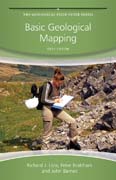
INDICE: PART of The Geological Field Guide Series, Basic Geological Mapping, 5th Edition is an essential basic guide to field techniques in mapping geology. Now completely revised and updated the book retains the concise clarity which has made it an indispensable instant reference in its previous editions. It provides the reader with all the necessary practical information and techniques that they will need while carrying out work in the field, covering a wide spectrum of different conditions, needs and types of countries. This edition covers new developments in technology including Google Earth and the use of GPS. This is an ideal field guide to geological mapping for 2nd/3rd year undergraduates of Geology, Hydrogeology and Geological Engineering. INDICE: Preface to the Fourth Edition ix Preface to the Fifth Edition xi 1Introduction 1 1.1 Outline and Approach 1 1.2 Safety 2 1.3 Field Behaviour 4 1.4 A Few Words of Comfort 5 2 Field Equipment 6 2.1 Hammers and Chisels 6 2.2Compasses and Clinometers 8 2.3 Hand Lenses 13 2.4 Tapes 14 2.5 Map Cases 14 2.6 Field Notebooks 15 2.7 Scales 16 2.8 Protractors 16 2.9 Pencils, Erasers and Mapping Pens 17 2.10 Acid Bottles 18 2.11 Global Positioning System (GPS) and Mobile Phones 19 2.12 Other Instruments 23 2.13 Field Clothing 26 3 Topographic Base Maps 27 3.1 Types of Geological Map 27 3.2 Topographic Base Maps 29 3.3 Geographic Coordinates and Metric Grids 30 3.4 Grid Magnetic Angle 33 3.5 Position Finding on Maps 34 3.6 Use of Air Photography as a Mapping Tool 43 3.7 Suitability of Images for Geological Mapping 48 4 Methods of Geological Mapping 50 4.1 Strategy for the Mapping Programme 50 4.2 Mapping by Following Contacts 51 4.3 Traversing 52 4.4 Exposure Mapping 55 4.5 Mapping in Poorly Exposed Regions 57 4.6 Superficial Deposits 62 4.7 Drilling 66 4.8 Geophysical Aids to Mapping 67 4.9 Large-Scale Maps of Limited Areas 71 4.10 Underground Mapping 74 4.11 Photogeology 76 5 Technological Aids to Mapping 80 5.1 Digital Terrain Models 80 5.2 Topographic Surveying Techniques 86 6 Field Measurements and Techniques 95 6.1 Measuring Strike and Dip of Planar Structures 95 6.2 Plotting Strike and Dip 101 6.3 Recording Strike and Dip 101 6.4 Measuring Linear Features 102 6.5 Folds 105 6.6 Faults 110 6.7 Thrusts 112 6.8 Joints 112 6.9 Unconformities 114 6.10 Map Symbols 114 6.11 Specimen Collecting 116 6.12 Field Photography 118 6.13 Panning 124 7 Mappable Rock Units and Lithology 126 7.1 Lithostratigraphy and Sedimentary Rocks 126 7.2 Sedimentary Formations 127 7.3 Rock Descriptions 128 7.4 Identifying and Naming Rocks in the Field 129 7.5 Fossils 133 7.6 Phaneritic Igneous Rocks 134 7.7 Aphanitic Igneous Rocks 135 7.8 Veins and Pegmatites 135 7.9 Igneous Rocks in General 136 7.10 Pyroclastic Rocks 138 7.11 Metamorphic Rocks 138 7.12 Economic Geology 140 8 Field Maps and Field Notebooks 146 8.1 Field Maps 146 8.2 Field Notebooks 154 9 Fair Copy Maps and Other Illustrations 162 9.1 Fair Copy Maps 162 9.2 Transferring Topography163 9.3 Transferring Geology 163 9.4 Lettering and Symbols 164 9.5 Formation Letters 165 9.6 Layout 165 9.7 Colouring 167 9.8 Stratigraphic Column 167 9.9 Overlays 168 9.10 Computer Drafting of the Fair Copy Map 169 10 Cross-Sectionsand 3D Illustrations 171 10.1 Cross-Sections 171 10.2 Method of Apparent Dips175 10.3 Down-Plunge Projection Method 177 10.4 Balanced Cross-Sections 179 10.5 Columnar Sections 179 10.6 Block Diagrams 180 10.7 Models 183 11 Geological Reports 185 11.1 Preparation 186 11.2 Revising and Editing 186 11.3 Layout 186 11.4 The 'Introduction' 188 11.5 Main Body of the Report 188 11.6 The 'Conclusions' Section 191 11.7 Text Illustrations 191 11.8 References 192 11.9 Appendices 193 11.10 Some Final Thoughts 193 Appe
- ISBN: 978-0-470-68634-8
- Editorial: John Wiley & Sons
- Encuadernacion: Rústica
- Páginas: 232
- Fecha Publicación: 26/08/2011
- Nº Volúmenes: 1
- Idioma: Inglés
